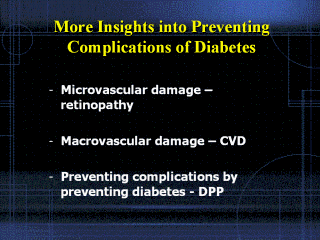| front |1 |2 |3 |4 |5 |6 |7 |8 |9 |10 |11 |12 |13 |14 |15 |16 |17 |18 |19 |20 |21 |22 |23 |24 |25 |26 |27 |28 |29 |30 |31 |32 |33 |34 |35 |36 |review |
 |
As we have seen with ESRD, it is possible – with insights gained
from NIH-supported research – to
successfully treat and prevent some complications of type 2
diabetes. I’d like to tell
you a little about our successes in preventing some of the other
complications of the disease.
Damage to the small blood vessels at the back of the eye –
microvascular damage – can lead to a condition
called diabetic retinopathy.
Diabetes is the leading cause of adult-onset blindness in the U.S.
However, thanks to a landmark study of patients with type 1
diabetes, we know that tight control of blood glucose levels can
prevent this damage and preserve eyesight.
Damage to the larger blood vessels of the body – macrovascular
damage – can lead to cardiovascular
disease (CVD). We now know
that tight control of blood glucose can dramatically lower the risk
of heart disease and stroke.
Finally, the Diabetes Prevention Program (DPP) clinical trial
showed that development of type 2 diabetes
could be prevented or delayed in high-risk individuals through
either drug treatment or a lifestyle intervention that included
reduced caloric intake and increased exercise.
|